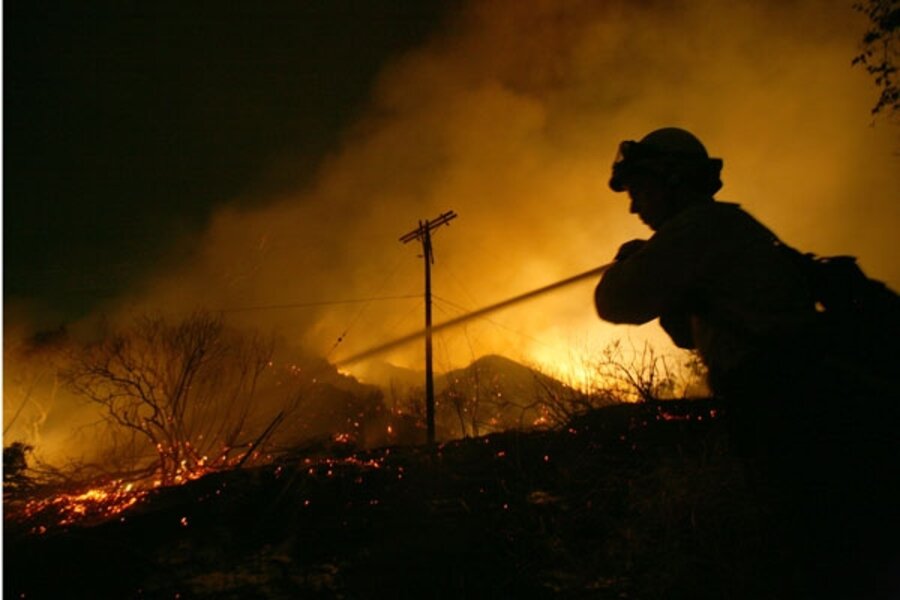Wildfires – the causes and solutions
Loading...
Whenever we read about or see photos of the latest big wildfire, most of us wonder if something couldn't have been done to prevent it. And if we live in the other 49 states, another question often arises: Why do wildfires occur so often in California?
What causes wildfires? Most often, people. Lightning is the No. 2 cause. But certain conditions have to be in place for those to have an effect. Here's how Time magazine explained it very simply some years back:
Wildfires result from a confluence of fuel, dryness and some kind of trigger. Each factor contributes to the severity of the blaze.
-- Fuel means flammable solids -- grass, pine needles, undergrowth, smaller trees -- that, with oxygen, feed the fire.
-- Dryness can be caused by short-term weather patterns with low humidity or by a lengthy drought that parches the landscape.
-- Triggers can be as natural as a lightning strike, as innocent as a campfire or as sinister as an arsonist.
But Smokeybear.com expands on this in explaining that many factors are involved in why so many acres have burned over the past few years. These include:
-- Past fire suppression policies which allowed for the accumulation of fuel in the form of fallen leaves, branches, and excessive plant overgrowth in forest and wildland areas.
-- Increasingly dry, hot weather.
-- Changing weather patterns across the US.
-- Increased residential development in the wildland/urban interface.
In California, winds – including the famous Santa Ana winds in the fall – often spread wildfires. "The hot Santa Ana winds not only spread existing fires very quickly, but also dry out vegetation, making more areas susceptible to fire," says the Environmental Literacy Council.
Southern California's topography also contributes to keeping the Golden State at the top of the annual acres burned by wildlfires list. "Steep slopes offer greater potential for increased fire intensity and more obstacles for fire fighting," notes the Arbor Day Foundation.
But what are possible solutions? Of the contributing factors for wildfires, we can't do much about lighting. And Smokey the Bear has been preaching about forest fire prevention for years. Drought or dryness is another factor beyond human control at this point.
That leaves the triggers -- grass, pine needles, undergrowth, smaller trees, etc. Can we do something about those? Yes, but it's controversial.
As Bill McEwen of The Fresno Bee noted last year:
Anyone who had paid attention to the problem surely recognizes what occurs after every big wildfire. Fire-science experts say that overgrown forests must be thinned. Environmentalists say that thinning is really an excuse to engage in destructive logging. And then everybody heads to court.
It shouldn't be that way, he adds:
Overgrown forests must be thinned because they're dangerous firetraps. But they must be thinned the right way-- with underbrush removed, erosion prevented and water quality maintained.
Officials in Colorado Springs, Colo, say that one reason the California fires have been so large is that the forested areas were allowed to become overgrown. They've been cutting down trees to prevent it happening there.
But it's a complicated issue, as seen in this PDF from Defenders of Wildlife.
Among other solutions to prevent more extensive damage from fires, Robert Nelson of George Mason University suggests:
-- Allow local California communities a greater role in providing funds, setting spending priorities, and making fire management decisions for the nearby national forest lands;
-- Create state fire districts following the model of air and water districts already found in California and include national forest lands within those districts under their oversight with respect to fire prevention and suppression; or
-- Transfer fire management responsibility entirely to the state and local level.
When it comes to damage from fires, "There is actually more flammable material in a house per square yard than in a forest," said Michael Ghil, UCLA distinguished professor of climate dynamics and geoscience, as reported in Science Daily. "Our study shows that fireproofing of homes is important not only for the houses, but also for the forest."
Sunset suggests landscaping that helps fight fire as well as five other ways to protect a home from wildfire.





